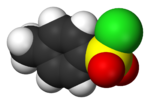| Revision as of 20:02, 9 November 2022 editSticklink (talk | contribs)177 editsm fix grammarTag: Visual edit← Previous edit | Latest revision as of 16:14, 28 July 2024 edit undoSmokefoot (talk | contribs)Autopatrolled, Extended confirmed users, Pending changes reviewers, Rollbackers74,550 edits <ref name=eEROS> | ||
| Line 71: | Line 71: | ||
| : CH<sub>3</sub>C<sub>6</sub>H<sub>5</sub> + SO<sub>2</sub>Cl<sub>2</sub> → CH<sub>3</sub>C<sub>6</sub>H<sub>4</sub>SO<sub>2</sub>Cl + HCl | : CH<sub>3</sub>C<sub>6</sub>H<sub>5</sub> + SO<sub>2</sub>Cl<sub>2</sub> → CH<sub>3</sub>C<sub>6</sub>H<sub>4</sub>SO<sub>2</sub>Cl + HCl | ||
| == Hazards == | == Hazards == | ||
| Tosyl chloride is |
Tosyl chloride is "a corrosive ]."<ref name=eEROS/> | ||
| ==References== | ==References== | ||
Latest revision as of 16:14, 28 July 2024

| |

| |
| Names | |
|---|---|
| Preferred IUPAC name 4-Methylbenzene-1-sulfonyl chloride | |
| Other names Tosyl chloride, p-toluenesulfonyl chloride, p-TsCl, TsCl | |
| Identifiers | |
| CAS Number | |
| 3D model (JSmol) | |
| ChemSpider | |
| ECHA InfoCard | 100.002.441 |
| PubChem CID | |
| UNII | |
| CompTox Dashboard (EPA) | |
InChI
| |
SMILES
| |
| Properties | |
| Chemical formula | C7H7ClO2S |
| Molar mass | 190.65 g/mol |
| Appearance | White solid |
| Melting point | 65 to 69 °C (149 to 156 °F; 338 to 342 K) |
| Boiling point | 134 °C (273 °F; 407 K) at 10 mmHg |
| Solubility in water | Reacts with water |
| Hazards | |
| Occupational safety and health (OHS/OSH): | |
| Main hazards | Releases HCl on contact with water |
| NFPA 704 (fire diamond) |
 |
| Flash point | 128 °C (262 °F; 401 K) |
| Except where otherwise noted, data are given for materials in their standard state (at 25 °C , 100 kPa).
| |
4-Toluenesulfonyl chloride (p-toluenesulfonyl chloride, toluene-p-sulfonyl chloride) is an organic compound with the formula CH3C6H4SO2Cl. This white, malodorous solid is a reagent widely used in organic synthesis. Abbreviated TsCl or TosCl, it is a derivative of toluene and contains a sulfonyl chloride (−SO2Cl) functional group.
Uses
Main article: TosylIn characteristic manner, TsCl converts alcohols (abbreviated ROH) into the corresponding toluenesulfonate esters, or tosyl derivatives ("tosylates"):
- CH3C6H4SO2Cl + ROH → CH3C6H4SO2OR + HCl
Tosylates can be cleaved with lithium aluminium hydride:
- 4 CH3C6H4SO2OR + LiAlH4 → LiAl(O3SC6H4CH3)4 + 4 RH
Thus, tosylation followed by reduction allows for removal of a hydroxyl group.
Likewise, TsCl is used to prepare sulfonamides from amines:
- CH3C6H4SO2Cl + R2NH → CH3C6H4SO2NR2 + HCl
The resulting sulfonamides are non-basic and, when derived from primary amines, are even acidic.
TsCl reacts with hydrazine to give p-toluenesulfonyl hydrazide.
The preparation of tosyl esters and amides are conducted in the presence of a base, which absorbs hydrogen chloride. The selection of the base is often crucial to the efficiency of tosylation. Typical bases include pyridine and triethylamine. Unusual bases are also used; for example, catalytic amounts of trimethylammonium chloride in the presence of triethylamine is highly effective by virtue of the trimethylamine.
Other reactions
Being a widely available reagent, TsCl has been heavily examined from the perspective of reactivity. It is used in dehydrations to make nitriles, isocyanides and diimides. In an unusual reaction focusing on the sulfur center, zinc reduces TsCl to the sulfinate, CH3C6H4SO2Na.
Manufacture
This reagent is inexpensively available for laboratory use. It is a by-product from the production of ortho-toluenesulfonyl chloride (a precursor for the synthesis of the common food additive and catalyst saccharin), via the chlorosulfonation of toluene:
- CH3C6H5 + SO2Cl2 → CH3C6H4SO2Cl + HCl
Hazards
Tosyl chloride is "a corrosive lachrymator."
References
- "P-TOLUENESULFONYL CHLORIDE (TOSYL CHLORIDE)".
- ^ Whitaker, D. T.; Whitaker, K. S.; Johnson, C. R.; Haas, J. (2006). "P-Toluenesulfonyl Chloride". p-Toluenesulfonyl Chloride. Encyclopedia of Reagents for Organic Synthesis. New York: John Wiley. doi:10.1002/047084289X.rt136.pub2. ISBN 978-0471936237. Archived from the original on 2016-03-05. Retrieved 2013-05-28.
- Ichikawa, J.; Nadano, R.; Mori, T.; Wada, Y. (2006). "5-endo-trig Cyclization of 1,1-Difluoro-1-alkenes: Synthesis of 3-Butyl-2-Fluoro-1-Tosylindole". Organic Syntheses. 83: 111; Collected Volumes, vol. 11, p. 834.
- Whitmore, F. C.; Hamilton, F. H. (1922). "Sodium Toluenesulfinate". Organic Syntheses. 2: 89; Collected Volumes, vol. 1, p. 492.
- Lindner, O.; Rodefeld, L. "Benzenesulfonic Acids and Their Derivatives". Ullmann's Encyclopedia of Industrial Chemistry. Weinheim: Wiley-VCH. doi:10.1002/14356007.a03_507. ISBN 978-3527306732.